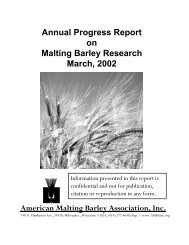Annual Progress Report on Malting Barley Research March, 2007
Annual Progress Report on Malting Barley Research March, 2007
Annual Progress Report on Malting Barley Research March, 2007
You also want an ePaper? Increase the reach of your titles
YUMPU automatically turns print PDFs into web optimized ePapers that Google loves.
envir<strong>on</strong>ments was practiced, 2) elite lines from Busch Agricultural <strong>Research</strong> (BARI)<br />
were evaluated allowing us to provide valuable informati<strong>on</strong> to area producers, and 3)<br />
testing locati<strong>on</strong>s were expanded to include a winter testing locati<strong>on</strong> in Hutchins<strong>on</strong>, KS.<br />
This locati<strong>on</strong> allows us to gain knowledge c<strong>on</strong>cerning the winterhardiness and heat and<br />
drought tolerance.<br />
Before 2003 our winter lines were tested <strong>on</strong>ly at Aberdeen, ID. In 2004 we were also<br />
able to evaluate at Parma, ID. In the fall of 2004 our winter lines were planted at<br />
Aberdeen, Filer, and Parma, ID., Pendlet<strong>on</strong>, OR, and Pullman, WA. In the fall of 2006<br />
we also planted these trials at Colby and Hutchins<strong>on</strong>, KS. These expanded winter<br />
testing locati<strong>on</strong>s provide a thorough representati<strong>on</strong> of literally hundreds of thousands of<br />
acres of highly productive winter small grain areas, giving us c<strong>on</strong>fidence we can<br />
c<strong>on</strong>tinue to release improved winter malting barley cultivars which can be grown <strong>on</strong><br />
large producti<strong>on</strong> areas. The additi<strong>on</strong>al locati<strong>on</strong>s in Kansas represent an area that is<br />
currently planted exclusively to winter wheat. We, at this point, d<strong>on</strong>’t propose that winter<br />
malting barley will so<strong>on</strong> become comm<strong>on</strong> in these areas, but these experimental plots<br />
should provide us some idea of the amount of heat and drought tolerance that exists in<br />
our germplasm. With c<strong>on</strong>tinuing water restricti<strong>on</strong>s in Idaho this may become a more<br />
pressing issue in the near future.<br />
We evaluated six elite lines from BARI in exchange for their testing our elite malt test at<br />
two additi<strong>on</strong>al locati<strong>on</strong>s: Idaho Falls, ID and Fairfield, MT. In the past our program has<br />
focused almost exclusively <strong>on</strong> Idaho but with the expansi<strong>on</strong> of testing our spring lines in<br />
M<strong>on</strong>tana, and our winter lines in Oreg<strong>on</strong> and Washingt<strong>on</strong>, we are now able to test for<br />
broader regi<strong>on</strong>al adaptati<strong>on</strong>.<br />
Objectives, Methodology, and Results:<br />
As in previous years our major objective is to develop, advance, and release improved<br />
malting barleys. The developmental phase of this included the development of 48 tworowed<br />
and 181 six-rowed F2 segregating populati<strong>on</strong>s that were advanced over the<br />
winter in New Zealand. In additi<strong>on</strong>, 38 F3 populati<strong>on</strong>s, with superior malt potential, were<br />
advanced in New Zealand. The remainder of the F3 and F4 populati<strong>on</strong>s were advanced<br />
in bulk at Aberdeen in 2006. A single F6 spike from 50 F5 plants per populati<strong>on</strong> was<br />
harvested and advanced via single seed descent to the F7 generati<strong>on</strong> over the summer<br />
in the greenhouse. A single plant was then grown over the winter and these will be<br />
planted as a single 2-row yield plot in <strong>2007</strong>. This will allow us to save two years in the<br />
developmental process by 1) advancing the generati<strong>on</strong> in the greenhouse and 2) begin<br />
yield testing in <strong>2007</strong> as a two-row plot. Approximately 12,000 of these 2-row plots will be<br />
tested then reduced to approximately selected 500 lines next seas<strong>on</strong>. In the summer of<br />
<strong>2007</strong> we will derive lines from F3 populati<strong>on</strong>s that were advanced in New Zealand this<br />
winter and therefore begin yield trials in 2008 for crosses that were made in 2005-06.<br />
11
















